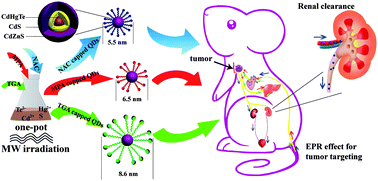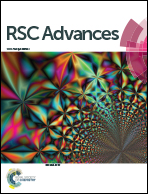Design of bright near-infrared-emitting quantum dots capped with different stabilizing ligands for tumor targeting†
Abstract
In this study, a facile formulation of near-infrared (NIR)-emitting CdHgTe/CdS/CdZnS quantum dots (QDs) was fabricated and coated with three different thiol ligands, N-acetyl-L-cysteine (NAC), 3-mercaptopropionic acid (MPA) and thioglycolic acid (TGA). The optical properties, morphology, hydrodynamic diameters, structure and surface chemistries of the developed QDs were comprehensively assessed. As a therapeutic drug, NAC provides excellent biocompatibility and anti-oxidant activity both in vitro and in vivo. Given their core–shell–shell structure, the QDs induced no toxicity in living bodies even at a concentration of 20 mg kg−1. Compared with NAC-capped QDs, TGA- and MPA-capped QDs demonstrated poor tumor-targeting capabilities because of their larger hydrodynamic diameters and inferior biocompatibility. Furthermore, the use of different stabilizing ligands resulted in various major changes in organ biodistribution and clearance from the body. In terms of rapid metabolization through renal clearance, the NAC-capped core–shell–shell QDs will be an alternative probe in cellular metabolism studies and image-guided surgery for tumor targeting and removal.



 Please wait while we load your content...
Please wait while we load your content...